Last updated: July 9, 2022
Article
The bioblitz: Good science, good outreach, good fun
By Gretchen M. Baker, Nancy Duncan, Ted Gostomski, Margaret A. Horner, and David Manski
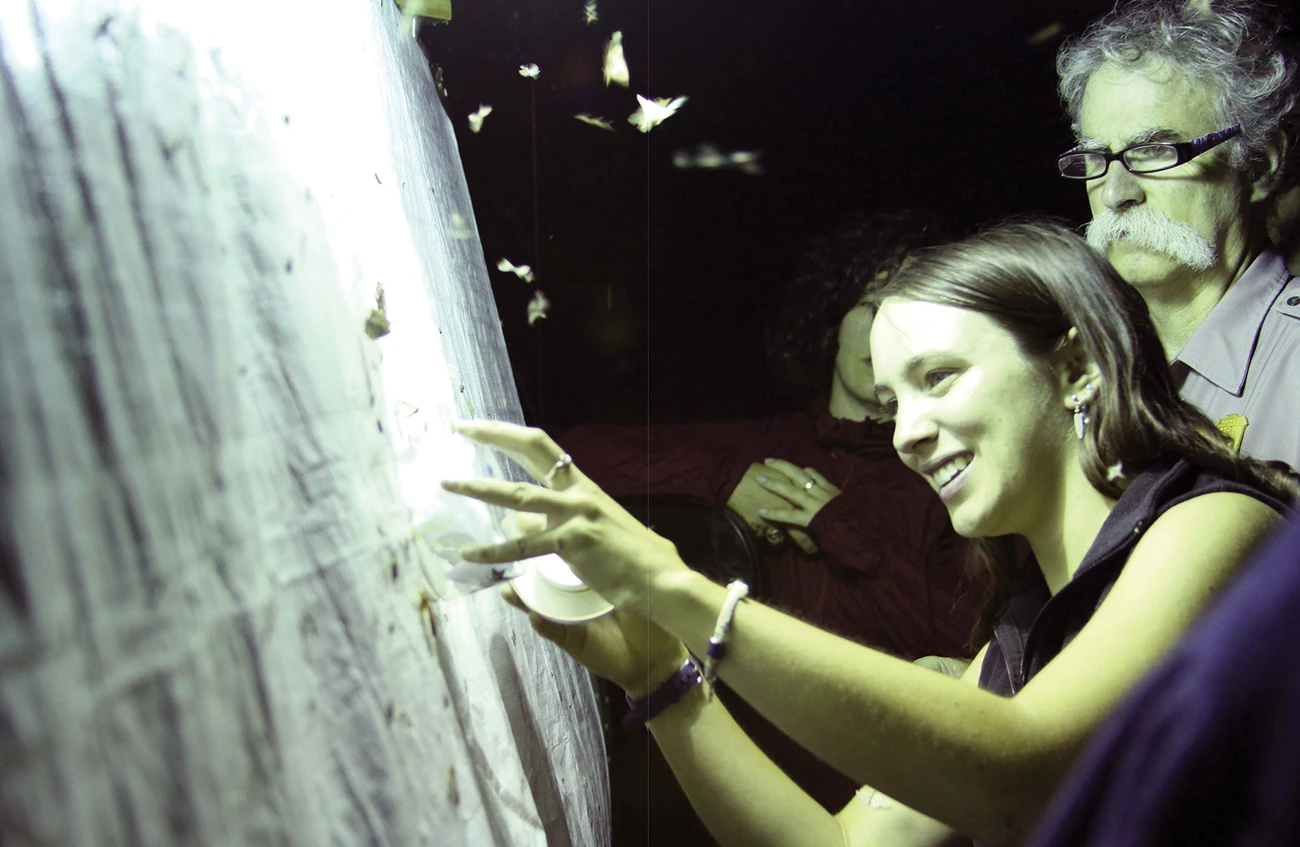
NPS photo / Diana Hunt
Part contest, part festival, part educational event, and part scientific endeavor, bioblitzes bring together naturalists, professional scientists, and the interested public, who canvass the area over a 24-hour period to find and document all plants and animals.
WOW! LOOK AT THAT! I never knew that!” The exclamations were coming from a man who, with a small group of people, was participating in a guided bird walk during a bioblitz at a small public park on Lake Superior in northern Wisconsin. The group was walking the road along a stand of red and white pines when a noisy flock of crows drew their attention to the top of one tree in particular.
“Watch that tree,” the group leader told them. “Crows make this sort of ruckus when they are mobbing a predator and trying to drive it out of the area. Maybe it will be an owl.”
It was June, early afternoon, and the sun was high. The small group watched the tree, occasionally using binoculars to scan the branches. Suddenly, an oblong form took flight from a branch near the top of the tree––a great horned owl (Bubo virginianus)––and the crows followed close behind it. The group leader was thrilled to add the owl to the list, and the man was thrilled to learn a little about bird behavior and a trick to finding secretive birds like owls in the middle of the day.
Similarly exciting discoveries are made commonly at any bioblitz. All observations like this are good for science and for the parks where bioblitzes are held, but they are most often exciting because the people making them are citizen scientists spending a day in their local national park and contributing to managers’ scientific knowledge of park resources. Some participants may have never been in the park before, and most may have never had an opportunity to spend a day in the field with professional naturalists and to make close personal contact with plants and animals.
What is a bioblitz?
The term “bioblitz” was coined in 1996 by a National Park Service (NPS) employee organizing the first such event at Kenilworth Park and Aquatic Gardens in Washington, D.C. More than half of the 90 participating scientists––who came from federal agencies, the Smithsonian Institution, and area universities––had never been to Kenilworth (Cohn 1996; Droege 1996). Since that first effort, the concept has been used all over the world as a means of gathering and sharing information about plants and animals in parks and other natural areas.
Why host a bioblitz? Park managers may seek to document the presence of rare or understudied taxa, while others may want to establish a baseline of information for a particular piece of land. Some may simply want to introduce people to their local national park. The goals of the event will dictate how it is focused and organized.
The searching can be done by profession als, by local volunteers with good naturalist backgrounds, or by a combination of the knowledgeable and the interested. In most cases, a bioblitz is conducted over a 24-hour period, so participants are out in the early morning to inventory songbirds, during the day to catch butterflies and fish and to collect plant specimens, and at night to trap moths or bats or to listen for owls. Because the event is held on a single day, it is not possible to find and document everything, but a bioblitz does give park managers a quick assessment of the plants and animals found in a given area. Plus, it gives participants an opportunity to spend a day outdoors, sharing time with family, friends, or like-minded enthusiasts.
Perhaps the most well-known national park bioblitz is the ongoing All-Taxa Biodiversity Inventory (ATBI) at Great Smoky Mountains (DLiA 2013). The ATBI is a different kind of bioblitz because it is not limited to one day and it has a stated goal of discovering all forms of life in the park. Other well-known bioblitzes are those organized by the National Geographic Society in a different national park each year during the decade leading up to the NPS centennial in 2016 (www.nationalgeographic.com/explorers/projects/bioblitz/).
We present here examples of bioblitzes from three different parks. Acadia and Great Basin National Parks (in Maine and Nevada, respectively) have conducted 18 bioblitzes between them, each focused on a specific group of organisms. Mississippi National River and Recreation Area (Minnesota) has conducted three bioblitzes, focusing on discrete locations along the riverway. All have used professional scientists to varying degrees, but Acadia is the only one specifically to focus participant recruitment on professionals while allowing casual public participation. All have the purpose of learning more about the park and the life within it.
Acadia National Park bioblitz program
Acadia has conducted annual bioblitzes since 2003, focusing primarily on insects and spiders, but adding mushrooms, algae, and diatoms in some years (table 1). Most events have occurred over one weekend in the summer at the Schoodic Education and Research Center (SERC). Collecting is generally limited to a 24-hour period, with sorting, pinning, and identifying speci- mens taking the rest of the weekend—and sometimes longer.
Event participation is intentionally kept low to ensure financial and operational sustainability. Participants are recruited primarily through the Maine Entomological Society, which also assists with marketing and general oversight of the event. The Maine Forest Service, University of Maine, and University of New Hampshire have also made in-kind contributions of staff time (entomologists) and equipment. The algae and diatom events coincided with professional scientific meetings at which conference participants were given a park research and collecting permit.
| Year | Taxon (Taxa) |
| 2003 | Ants |
| 2004 | Butterflies and moths |
| 2005 | Beetles |
| 2006 | Flies |
| 2007 | Spiders |
| 2008 | True bugs |
| 2009 | Minor orders of insects, mushrooms |
| 2010 | Bees, wasps, ants |
| 2011 | Butterflies and moths |
| 2012 | Aquatic insects, algae |
| 2013 | Beetles and diatoms |
| 2014 | Beetles |
Participants are housed and fed at the SERC by the Schoodic Institute, the National Park Service’s nonprofit partner that manages and runs programs on campus. Lead taxonomists (usually one or two for each event) are given an honorarium of up to $1,000 for their oversight of the event, teaching participants about the target taxa, completing a summary bioblitz report, identifying specimens, and returning pinned and labeled voucher specimens that are incorporated into the park’s museum collection.
Participation by the public is not actively solicited, but no one with a keen interest is turned away. A separate two-hour public education session runs during each bioblitz. Participants learn about the taxa being studied and then are allowed to assist in making collections. Public participants can also watch the bioblitz lab in operation as specimens are identified and cataloged, then meet the scientists involved in the event. Annual attendance varies from 35 to 110, with an average participant return rate of 75%.
Through 2011, collecting was geographically limited to the Schoodic District of the park, which lies approximately 5 miles (8 km) east of Mount Desert Island. In 2012 the main portion of Acadia—Mount Desert Island—was added. Sites that cover the full diversity of habitats within the park are targeted, but participants are also allowed to sample in other areas they choose.
All incoming specimens from a single collection event are assigned a “lot” number that is linked to the date, time, location, and method of capture. Lot numbers are unique and not reused in subsequent years. They are handwritten on preprinted labels as the samples are processed so that mounting and labeling can proceed quickly and the collection information can be tracked as identifications are made.
Collection locations are assigned GPS coordinates in the field, or when the specimens are brought in for processing and given their lot number. This information is recorded in a database along with the habitat and host plants where the specimens were taken, the name of the collector, and any pertinent descriptions of the collecting technique. All specimens are then sorted, and at least one representative of each morphospecies (a species established solely on the basis of morphological characteristics) is pinned or placed in an alcohol vial as appropriate with locality labels. Many bioblitz participants assist in sorting and pinning specimens at the SERC laboratory. Experienced entomologists identify the specimens to species or morphospecies, but the lead taxonomist is responsible for proofing and accepting any identifications made by others.
A practical goal is to sort and identify as many specimens as possible on-site during the event when the greatest number of participants can contribute at their relative levels of expertise. However, not all specimens can be identified in this time period. In those cases the lead taxonomist takes the unidentified specimens back to his or her host institution for follow-up work or distribution to other specialists for final identification. For some families or genera there are no specialists available to identify the specimens to the species level, or in some cases even to the genus level. Specimen identifications are entered in the database at the finest level possible, and labeled representative vouchers of all collected species are held at Acadia’s Charles Sawtelle Museum. More than 1,600 voucher specimens have been cataloged into Acadia’s museum collection.
The bioblitzes have yielded a great deal of information about some otherwise poorly understood biota, including many range extensions and more than 500 new park species records; more than 100 species records are new to the state of Maine. The University of Maine Agricultural and Forest Experiment Station has published a major technical report on the first nine years of bioblitz data (Chandler et al. 2011). There is a lot of regional interest, support, and encouragement for the bioblitz program—everyone wants it to continue––and there is now a cadre of individuals who are enthusiastic about the National Park Service and Acadia.
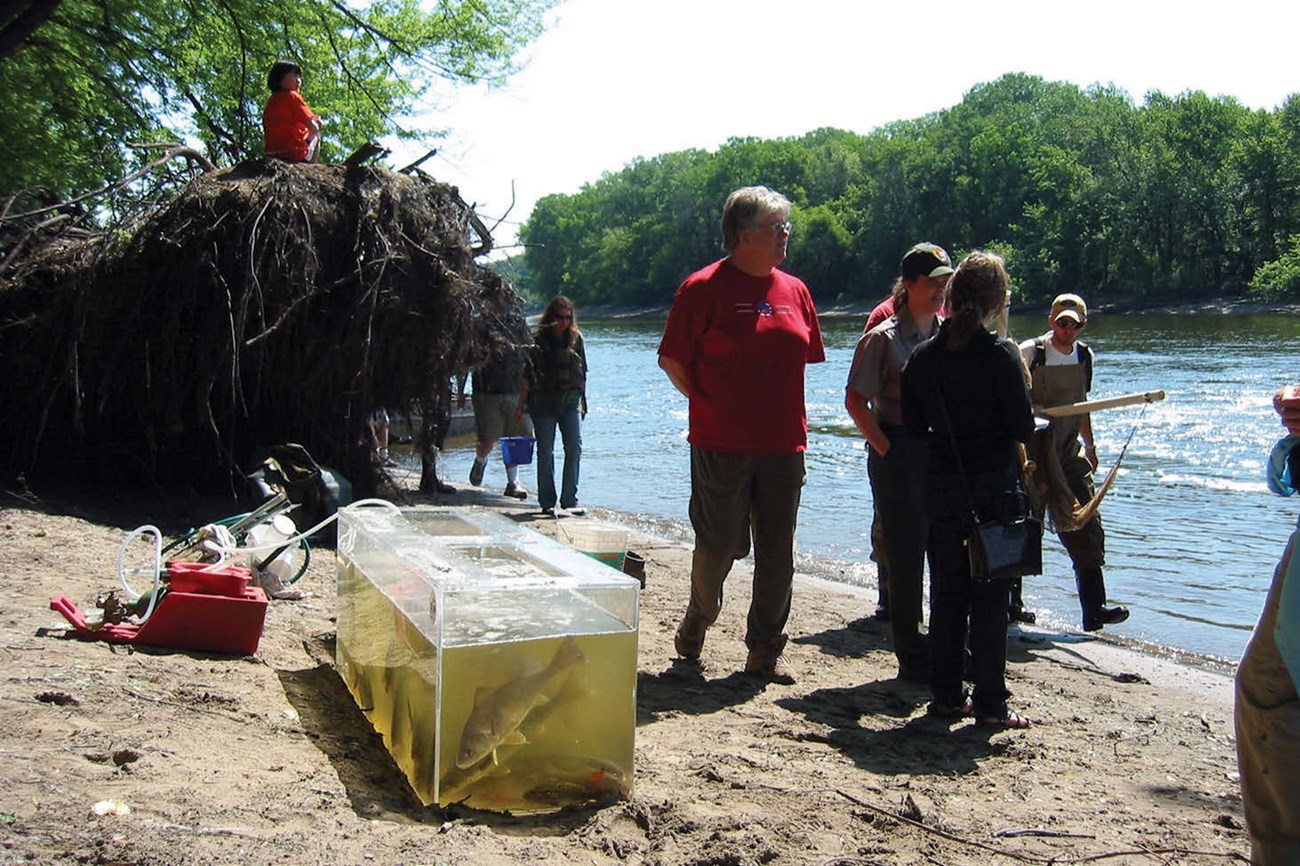
NPS photo / Ted Gostomski
Wild in the city: Minnesota bioblitz events at Mississippi National River and Recreation Area
One challenge for resource-rich national parks located in urban environments is that they are often overlooked because of the hustle and shine of the cities around them. If managers can make a park experi- ence part of city life, they can open doors for a set of visitors who may not have any other opportunity to catch a glimpse of the natural world around them. Mississippi National River and Recreation Area is one such park.
Mississippi National River and Recreation Area was established in 1988 to recognize and protect the history, industry, and natural resources within and along a 72-mile (116 km) stretch of “working river” that bisects downtown Minneapolis and St. Paul, Minnesota, home to more than 667,000 people. It is also distinct in that it connects a series of city, county, and state parks, which make up most of the land base of this national park unit.
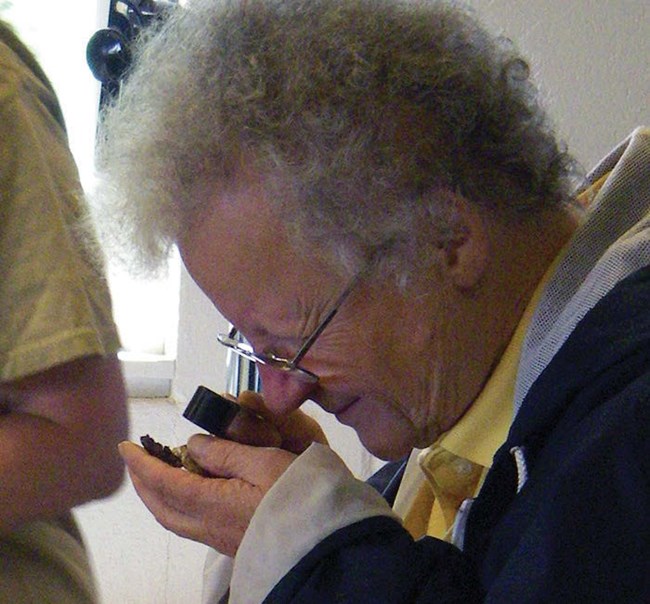
NPs photo / Ted Gostomski
One way park managers are introducing city residents to their local national park is by working with partners and major sponsors––including the Bell Museum of Natural History (University of Minnesota) and the nonprofit Mississippi River Fund––to hold bioblitzes in different sections of the riverway. This collaboration leads to savings in staff time and expense, while building stronger partnerships. Part contest, part festival, part educational event, and part scientific endeavor, bioblitzes bring together naturalists, professional scientists, and the interested public, who canvass the area over a 24-hour period to find and document all plants and animals.
Rather than roaming all 72 miles of the riverway in search of a particular group of organisms, Mississippi River bioblitzes focus on a particular location. That is how the Bell Museum was doing the bioblitzes before the National Park Service became involved, so the park simply adopted their procedures. In addition, intensive surveys at a single location provide more comprehensive information about species presence and abundance at that place.
The first bioblitz was held in June 2009 at Crosby Farm Regional Park, the largest natural area (763 acres, or 309 ha) in St. Paul’s city park system. More than 100 citizen volunteers and professional scientists participated, along with numerous people who happened to be in the park and stopped by to see what was happening. The survey covered floodplain forest; steep, wooded slopes cloaked mostly in oak forest; and a scattering of wetlands and small lakes. The small lakes serve as nurseries for young fish and other aquatic organisms that move into the main river during floods that connect the two water bodies.
Volunteers tallied 563 species of flora and fauna (table 2), including two species of endangered mollusks (the wartyback, Quadrula nodulata, and rock pocketbook, Arcidens confragosus); numerous fox snakes (Elaphe vulpina), possibly indicating that the area supports a breeding population; and river otters (Lontra canadensis), which had been absent from the riverway for some time. A parkwide survey the following year found otters throughout the park’s portion of the river, so a long-term research project was initiated to gather basic natural history information. Currently, park and U.S. Geological Survey biologists are working to identify genetic markers they can use to determine the size of the otter population and its genetic diversity within the upper Mississippi River corridor.
| Taxa
|
|||||||||||
| Site (acres/hectares) | Mammals | Birds | Reptiles | Amphibians | Insects | Plants | Fungi | Fish | Mollusks | Invertebrates (spiders) | Total Number of Species |
| Crosby Farm Regional Park (763/309) | 14 | 80 | 5 | 4 | ~110 | 241 | 57 | 33 | 19 | n.d. | 563 |
| Ordway Field Station (300/121) | 7 | 53 | 5 | 5 | 208 | 192 | 78 | 30 | 4 | 29 | 611 |
| Coldwater Spring (92/37) | 7 | 53 | 3 | 2 | 168 | 217 | 83 | 20 | n.d. | 5 (16) | 574 |
| Note: n.d. indicates no data. | |||||||||||
The 2011 bioblitz was held at the Katharine Ordway Field Station, owned by Macalester College. Here, volunteers combed through tallgrass prairie; sand gravel prairie; oak savanna and woodland; riparian forests; seasonal and permanent ponds, seeps, and springs; and a backwater lake adjacent to the Mississippi River. Despite intermittent drizzle, this event garnered 611 species at final count.
In 2013 the bioblitz moved to the 92-acre (37 ha) Coldwater Spring site. The National Park Service acquired 29 of those acres in 2010 from the U.S. Bureau of Mines, and in the two years leading up to the bioblitz, a dozen abandoned buildings were demolished and park staff began restoring the upland area to a mix of oak savanna, wetlands, and prairie.
One hundred volunteers ranging in age from 2 to 90 and with a wide variety of skills and experience assisted bioblitz scientists in documenting the presence of 574 species. Parents commented on how much their kids enjoyed collecting bugs and mammals and seeing the fish that were brought from the river. Even a late-night owl walk was a big hit among casual participants, despite a lack of calling owls. People enjoyed simply being out at night, in the park, savoring the knowledge that these mysterious birds were out there in the dark, even in the city.
Information acquired during the bioblitzes is helping park resource managers in numerous ways. First, there is increasing awareness of what biota are found within the riverway. Several species observed during the 2009 bioblitz were new to the park. That information has led to follow-up studies focusing on fungi, insects, and frogs. Second, the 2013 bioblitz at Coldwater Spring provided excellent baseline data for the property in its first year since site restoration had begun. Park staff plan to hold a bioblitz there every five years to document change in species composition and numbers as restoration of the area continues and plantings mature.
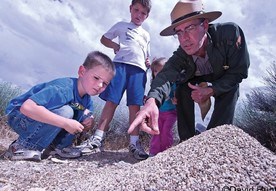
David Hunter
Sampling understudied taxa in Great Basin National Park
What species occur in Great Basin National Park? For many taxa, including plants, mammals, birds, reptiles, and fish, this question has been answered through targeted sampling and data collection since the park’s establishment in 1986. However, data on invertebrates—an abundant but understudied taxon—have been incomplete or absent. To help fill this knowledge gap, the park decided to use the bioblitz approach to sample, identify, and catalog invertebrates in the park.
Because of Great Basin’s relatively small size (77,000 acres or 31,161 hectares) and remote location (286 miles, or 460 km northeast of Las Vegas), there is a limited pool of subject-matter experts and volunteers interested enough to come to the park and assist with plant and animal surveys. Furthermore, because many areas in the park are difficult to access, a bioblitz focused on different park units or regions was not an option. Therefore, to maximize participation and efficiency, Great Basin staff, as at Acadia, chose to focus their bioblitzes on one order or class of organisms per year.
Park staff were introduced to the bioblitz concept during a program session at the 2009 George Wright Society Conference on Park and Protected Area Management in Portland, Oregon. After returning home, the park established a partnership with Southern Utah University to assist with the first bioblitz at Great Basin.
The primary objectives of the Great Basin bioblitzes are as follows:
- Conduct inventories for taxa not included in the National Park Service Inventory and Monitoring Program
- Determine which invertebrate species are present in the park
- Expand the number of species known to occur in the park
- Collaborate with subject-matter experts from various agencies and universities to strengthen park partnerships
- Engage citizen scientists to help develop park stewards
- Share results to initiate additional studies in the park
- Establish an invertebrate reference collection for park staff and visiting researchers
The park does not have a prioritized list of invertebrates to determine the focal group each year. Instead, the availability of a lead taxonomist helps the park decide how to focus the event. This lead taxonomist is responsible for leading a workshop, demonstrating sampling techniques, identifying specimens to the family level during the event, and providing the expertise, staff, and lab capacity to identify the specimens to the finest taxonomic level by the following year.
The park has now hosted six annual bioblitzes, with a budget ranging from $500 to $7,500 (table 3). The budget covers a stipend for the principal taxonomist, supplies, and salaries of seasonal employees whose time is dedicated to the event. The park was fortunate to have one bioblitz participant, Dr. Ken Kingsley, volunteer to serve as the first taxonomist-in-the-park. Dr. Kingsley spent one week each month during summer 2012 collecting, organizing, and curating the growing invertebrate collection. The Nevada State Entomologist’s office has also been an indispensable partner, bringing additional collecting equipment, microscopes, and knowledgeable staff to make each event run smoothly.
| Year | Order/Class | Common Name | Lead Taxonomist | Participants | Taxa Families Added | Species Added | Notes |
| 2009 | Coleoptera | Beetles | Jeff Knight, Nevada State Entomologist | 40 | 9 | 25+ | Organizational support from Southern Utah University |
| 2010 | Orthopteroids | Crickets, Grasshoppers, Related | Dr. Andrew Barnum, Dixie State College | 25 | 4 | 15 | Inclement weather |
| 2011 | Hymenoptera | Bees, Wasps, Ants | Dr. James Pitts, Utah State University | 80 | 25 | 100+ | First 48-hour event |
| 2012 | Diptera | Flies | Dr. Riley Nelson, Brigham Young University | 50 | 15 | 30+ | NPS Biodiversity Coordinator Sally Plumb attends |
| 2013 | Arachnids | Spiders, Mites, Ticks, Pseudoscorpions, Solfugids, Scorpions | Dr. Paula Cushing, Denver Museum of Nature and Science | 60 | >10 | 30+ | Nighttime activities attract significant attendance |
| 2014 | Lepidoptera | Butterflies, Moths | Dr. Paul Opler, Colorado State University | 60 | n/a | 200+ | New moth species |
| 2015 | Ephemeroptera, Plecoptera, Trichoptera | Mayflies, Stoneflies, Caddisflies | To be determined | n/a | n/a | n/a | May/June 2015 |
Great Basin National Park is generally undersampled for most invertebrate orders, and the bioblitzes provide an opportunity for scientists to apply their knowledge in a beautiful setting where the results will be used. The gathering of scientists at a bioblitz also serves to train graduate students, meet colleagues in the same or a similar field, and share knowledge with park visitors who are eager to learn.
Students and children are always welcome at bioblitzes and have helped collect and sort specimens. A high school teacher from Colorado brought his summer biology class to the 2011 Hymenoptera bioblitz, and they helped collect many additional specimens. Children, with their lower stature and innate curiosity, have helped their parents and scientists find insects and arachnids that otherwise would probably have been missed. In 2013, Dr. Paula Cushing gave a special presentation about arachnids to children, focusing on Charlotte’s Web. Children (and adults) could touch a real orbweaver spider, and some children who had always been afraid of spiders suddenly became their advocates.
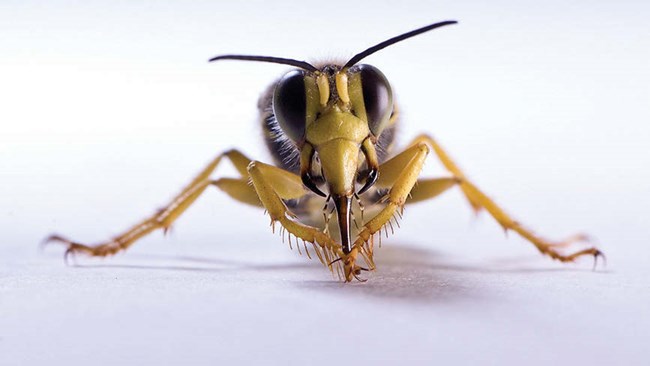
David Hunter
A potential new species to science (Acanthetropis sp. nov.) was documented during the Hymenoptera bioblitz in 2011, and the Arachnid bioblitz documented two orders (Solfugids and Scorpions) that were new to the park. More than 75 families have been added to the park’s taxonomic list along with numerous genera and species, providing a more complete species list for the park. Park staff are looking forward to future bioblitzes, and the focal groups are already identified for 2015 (Ephemeroptera, Plecoptera, and Trichoptera––the aquatic insect orders of mayflies, stoneflies, and caddisflies). The information gained from these bioblitzes fosters a greater awareness of the park’s biodiversity among both managers and the public. It can also help drive management decisions about where to focus conservation efforts by elucidating locations where more intense sampling and additional research are needed in order to determine species trends.
The diversity of life in our national parks is phenomenal, and the bioblitz has become a popular way of documenting that life and facilitating personal discoveries of it for the visiting public. If every bioblitz has a person who makes as exciting a discovery as a species new to science or even to the park, or who simply learns how to follow the sound of crows to a hidden owl, then the event is a job well done.
Literature cited
Chandler, D. S., D. Manski, C. Donahue, and A. Alyokhin. 2011. Biodiversity of the Schoodic Peninsula: Results of the insect and arachnid bioblitzes at the Schoodic District of Acadia National Park, Maine. Maine Agricultural and Forest Experiment Station Technical Bulletin 206. Accessed 24 April 2014 at http://digitalcommons.library.umaine.edu/aes_techbulletin/11/.
Cohn, D. 1996. Scientists invade [northeast] park: 24-hour survey strives to log nature’s diversity. Originally published in The Washington Post. Accessed 21 April 2014 at http://www.pwrc.usgs.gov/blitz/biopost.html.
Discover Life in America (DLiA). 2013. Fifteen years of discovery. DLiA white paper. Accessed 22 April 2014 at http://www.dlia.org/atbi/.
Droege, S. 1996. Species list (May 31–June 1, 1996), Kenilworth Park and Aquatic Gardens––BioBlitz. Accessed 21 April 2014 at http://www.pwrc.usgs.gov/blitz/species.html.
About the authors
Gretchen M. Baker (gretchen_baker@npse-mail us is an ecologist at Great Basin National Park in Baker, Nevada.
Nancy Duncan e-mail us is the Natural Resource Program manager at Mississippi National River and Recreation Area inSt. Paul, Minnesota.
Ted Gostomski e-mail us is a biologist and science writer with the NPS Great Lakes Inventory and Monitoring Network in Ashland, Wisconsin.
Margaret A. Horner is a supervisory biological technician at Great Basin National Park.
David Manski (david_manski@partner e-mail uss the former chief of Natural Resource Management and acting deputy superintendent at Acadia National Park, Bar Harbor, Maine. An “emeritus” employee, he recently retired from the National Park Service after a 35-year career on various natural and cultural resource assignments in the United States and abroad.
